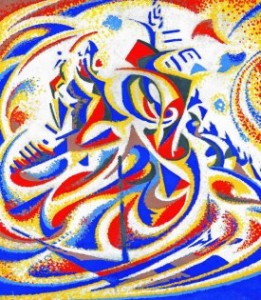Jules Schmalzigaug. Un futuriste belge
November 29, 2010 – February 6, 2011
Royal Museums of Fine Arts, Regentschapsstraat3, Brussels
Catalog with text by Willard Bohn, Giovanni Lista and Valerie Verhack
Google Translated from De Standaard by Jan Van Hove:

BRUSSELS – The Antwerp painter Jules Schmalzigaug won a place in art history because he is the only Belgian was associated with Futurism, one of the main currents in modern art.
The Royal Museums of Fine Arts exhibition have an attractive home on a somewhat forgotten but fascinating character: the Antwerp Jules Schmalzigaug. The vibrant colors and dancing lines of his futuristic paintings up against the crisp white walls beautifully. There is a graceful, ethereal atmosphere in the room that you immediately curiosity for the artist behind this work.
Jules Schmalzigaug (1882-1917)was the son of a wealthy Antwerp merchant. During his school years he was diagnosed with scoliosis established a deformity of the spine. He was sent for treatment to an institute in Dessau. There he taught include the landscape painter Paul Riess, who noted Schmalzigaug drawing talent. A short time later he decided to become an artist.
The story of the first year Schmalzigaug was not exceptional. A time he studied at the Academy of Antwerp, traveled to Italy and went to work occasionally in Bruges because the special atmosphere of this historic city enchanted him. He also went to Paris, where he exhibits the work met the then avant-garde, as Cubists Braque and Picasso and fauvist Kees van Dongen.
In 1912 something happened that changed his life. He first saw an exhibition of the Futurists and attended a lecture by Marinetti, the flamboyant leader of the movement. Although his family – financially supported by the young artist – he warned of Marinetti’s revolutionary ideas, he decided to live in Italy, where it came from Futurism.
Dynamics
For two happy years Schmalzigaug hired a studio in Venice and he painted faces of the main monuments and charming places of the lagoon city. During that period he came into contact with leading futurists such as Giacomo Balla and Umberto Boccioni. In 1914 he participated in a major exhibition of the Futurists in Rome, where other foreign avant-garde artists, including Kandinsky and Archipenko, were invited.
Schmalzigaug was accosted by a radical break with the tradition that stood for the futurism. In their artwork the futurists wanted the energy and dynamism of modern life capture. They saw the poetry of machines, motors and electric lighting and were fascinated by speed and movement. But it was the aesthetics of futurism that Schmalzigaug appealed. His whole life aimed to ensure that the light and colors in his work as intense as possible.
The titles of Schmalzigaug paintings speak volumes. Dynamic expression of a motorcycle at full speed, for example, or develop a rhythm: Electric Light + 2 dancers. He was totally different issues involved than the sunsets and flower still lifes that the public do got to see .
At the outbreak of World War Schmalzigaug returned to Antwerp. He followed his family into exile in The Hague. Once more he exhibited in Amsterdam, but the reactions of the critics were lukewarm. In 1917 he committed suicide for unknown reasons.
In Belgium, where he exhibited during his lifetime never had Schmalzigaug always remained an outsider. However, some dedicated collectors of his work and the museums of Brussels and Antwerp acquired paintings by his hand. In Italy he is known: his name appears in the correspondence of the futurists, who liked and regarded as one of their own. Two years ago a painting of Schmalzigaug, the dynamics of the dance, 240,000 euros at auction at Christie’s in London.
The exhibition at the Royal Museum is a rare opportunity for the artist, who had the courage to explore new paths, in all its facets to know.
The exhibition runs until February 6th at the Royal Museums of Fine Arts, Regentschapsstraat3, Brussels.